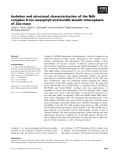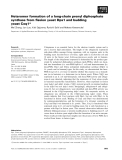
The structure of electronic systems
-
Glutathione reductase (GR) recycles oxidized glutathione (GSSG) by converting it to the reduced form (GSH) using an NADPH as the electron source. The function of GR in the male genital tract of the rat was examined by meas-uring its enzymatic activity and examining the gene expression and localization of the protein.
 9p
9p  research12
research12
 29-04-2013
29-04-2013
 46
46
 3
3
 Download
Download
-
Cytochrome P450BM3is a self-sufficient fatty acid mono-oxygenase consisting of a diflavin (FAD/FMN) reductase domain and a heme domain fused together in a single polypeptide chain. The multidomain structure makes it an ideal model system for studying the mechanism of electron transfer and for understanding P450 systems in general. Here we report the redox properties of the cyto-chrome P450BM3 wild-type holoenzyme, and its isolated FADreductase andP450 heme domains, when immobilized in a didodecyldimethylammonium bromide film cast on an edge-plane graphite electrode....
 7p
7p  tumor12
tumor12
 20-04-2013
20-04-2013
 46
46
 3
3
 Download
Download
-
The cell line, RCS-LTC (derived from the Swarm rat chondrosarcoma), deposits a copious extracellular matrix in which the collagen component is primarily a polymer of partially processed type II N-procollagen molecules. Transmission electron microscopy of the matrix shows no obvious fibrils, only a mass of thin unbanded filaments. We have used this cell system to show that the type II N-pro-collagen polymer nevertheless is stabilized by pyridinoline cross-links at molecular sites (mediated by N- and C-telo-peptide domains) found in collagen II fibrils processed nor-mally....
 8p
8p  tumor12
tumor12
 20-04-2013
20-04-2013
 29
29
 1
1
 Download
Download
-
The opportunity to design enzymatic systems is becoming more feasible due to detailed knowledge of the structure of many proteins. As a first step, investigations have aimed to redesign already existing systems, so that they can performa function different from the one for which they were syn-thesized. We have investigated the interaction of electron transfer proteins fromdifferent systems inorder to check the possibility of heterologous reconstitution among members of different chains.
 10p
10p  tumor12
tumor12
 20-04-2013
20-04-2013
 36
36
 3
3
 Download
Download
-
We measured cocrystals of the membrane protein Photosystem I with its soluble electron acceptor ferredoxin for the first time at the ALS (Berkeley, CA). Previous data collected at our home source and at other synchrotron sources showed crystals with very high mosaicity (2–5%) and a diffraction limit to 7–8 Aresolution. This first beamtime at ALS was very successful and may represent a breakthrough for the determination of the crystal structure. 110 crystals, grown under modified crystallization conditions, were scanned and for the first time, crystals diffraction to 3.5 A were observed....
 17p
17p  fptmusic
fptmusic
 11-04-2013
11-04-2013
 31
31
 2
2
 Download
Download
-
Complex I (NADH: ubiquinone oxidoreductase) is the first complex in the respiratory electron transport chain. Homologs of this complex exist in bacteria, mitochondria and chloroplasts. The minimal complex I from mitochondria and bacteria contains 14 different subunits grouped into three modules: membrane, connecting, and soluble subcomplexes. The com-plex I homolog (NADH dehydrogenase or Ndh complex) from chloroplasts from higher plants contains genes for two out of three modules: the mem-brane and connecting subcomplexes. ...
 12p
12p  awards
awards
 06-04-2013
06-04-2013
 26
26
 3
3
 Download
Download
-
Biomolecule–nanoparticle (NP) [or quantum-dot (QD)] hybrid systems combine the recognition and biocatalytic properties of biomolecules with the unique electronic, optical, and catalytic features of NPs and yield com-posite materials with new functionalities.
 8p
8p  inspiron33
inspiron33
 23-03-2013
23-03-2013
 51
51
 4
4
 Download
Download
-
Ubiquinone is an essential factor for the electron transfer system and is also a known lipid antioxidant. The length of the ubiquinone isoprenoid side-chain differs amongst living organisms, with six isoprene units in the budding yeastSaccharomyces cerevisiae, eight units in Escherichia coliand 10 units in the fission yeast Schizosaccharomyces pombeand in humans.
 16p
16p  galaxyss3
galaxyss3
 07-03-2013
07-03-2013
 51
51
 4
4
 Download
Download
-
Mitochondrial cytochromescandc1 are present in all eukaryotes that use oxygen as the terminal electron acceptor in the respiratory chain. Matura-tion of c-type cytochromes requires covalent attachment of the heme cofac-tor to the protein, and there are at least five distinct biogenesis systems that catalyze this post-translational modification in different organisms and organelles.
 18p
18p  media19
media19
 06-03-2013
06-03-2013
 39
39
 4
4
 Download
Download
-
The chloroplast thylakoid is the most abundant membrane system in nat-ure, and is responsible for the critical processes of light capture, electron transport and photophosphorylation. Most of the resident proteins are imported from the cytosol and then transported into or across the thyla-koid membrane.
 10p
10p  vinaphone15
vinaphone15
 27-02-2013
27-02-2013
 34
34
 2
2
 Download
Download
-
Nitric oxide synthases belong to a family of dual-flavin enzymes that trans-fer electrons from NAD(P)H to a variety of heme protein acceptors. Dur-ing catalysis, their FMN subdomain plays a central role by acting as both an electron acceptor (receiving electrons from FAD) and an electron donor, and is thought to undergo large conformational movements and engage in two distinct protein–protein interactions in the process.
 16p
16p  vinaphone15
vinaphone15
 25-02-2013
25-02-2013
 28
28
 3
3
 Download
Download
-
Opinion Progress towards mapping the universe of protein folds Alastair Grant, David Lee and Christine Orengo Address: Department of Biochemistry and Molecular Biology, University College, Gower Street, London WC1E 6BT, UK. Correspondence: Alastair Grant. E-mail: grant@biochem.ucl.ac.uk comment Published: 29 April 2004 reviews Genome Biology 2004, 5:107 The electronic version of this article is the complete one and can be found online at http://genomebiology.
 0p
0p  thulanh21
thulanh21
 15-11-2011
15-11-2011
 57
57
 1
1
 Download
Download
-
Published: 25 August 2004 Genome Biology 2004, 5:343 The electronic version of this article is the complete one and can be found online at http://genomebiology.com/2004/5/9/343 © 2004 BioMed Central Ltd reports A report on the Keystone Symposium ‘Structural Genomics’, held concurrently with the ‘Frontiers in Structural Biology’ symposium, Snowbird, USA, 13-19 April 2004.
 4p
4p  thulanh19
thulanh19
 09-11-2011
09-11-2011
 52
52
 2
2
 Download
Download






















